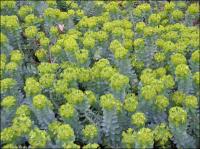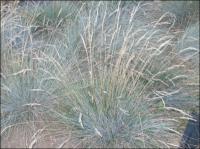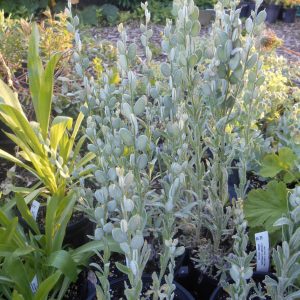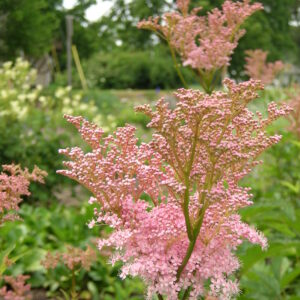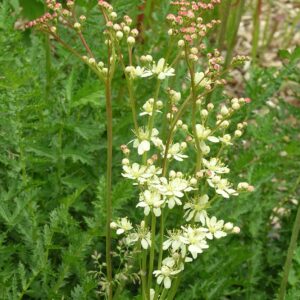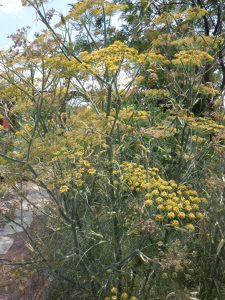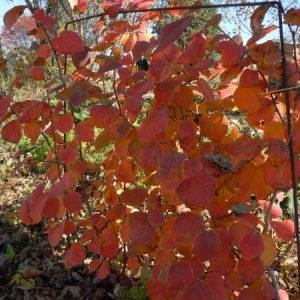Our Plants
Showing 225–232 of 587 results
-
Euphorbia myrsinites Donkeytail spurge Z 5-8
Chartreuse umbels at stem tips in early spring contrast succulent blue-gray foliage encircling the reclining stem.
Chartreuse umbels at stem tips in early spring contrast succulent blue-gray foliage encircling the reclining stem.
Can not ship to: Colorado.
Size: 4” x 12”
Care: Sun in well-drained soil
Native: Western Asia
Awards: Royal Horticultural Society Award of Merit.Euphorbia was named for Euphorbus, physician of Numibian King Juba, father of Ptolemy (c. 50 B.C. – 20 A.D.) Reputedly Euphorbus used spurge to remedy the King’s enlarged stomach. Euphorbus’s brother was Augustus Caesar’s physician. Myrsinites is a Greek word meaning “resembling myrtle.” This plant described by Swiss botanical scholar Conrad Gesner in his book Horti Germaniae published in 1541.
-
Euphorbia polychroma Cushion spurge syn. Euphorbia epithymoides Z 4-9
May – June a clump of flashy chartreuse bracts frame each flower altogether growing in a dome 12-18" tall and wide on erect, sturdy stems. In fall foliage turns orangey-red.
May – June a clump of flashy chartreuse bracts frame each flower altogether growing in a dome 12-18″ tall and wide on erect, sturdy stems. In fall foliage turns orangey-red.
Size: 16" x 24"
Care: Sun, moist well-drained humusy soil.
Native: Central and Southern Europe
Awards: Royal Horticultural Society Award of Garden Merit.Polychroma means many colors referring to the fact that the foliage changes colors. Named by Swedish botanist Linnaeus 1753.
-
Festuca ovina var. glauca Blue fescue Z 4-10
Short mound of silvery blue spiky grass tufts. In summer short spikes of blue-green flowers.
Short mound of silvery blue spiky grass tufts. In summer short spikes of blue-green flowers.
Size: 12" x 10"
Care: full sun, well-drained soil
Native: temperate areas in Europe
Wildlife Value: host for larvae of a few butterfliesFestuca is Latin meaning “grass stalk..” This variety described and named in 1881
-
Fibigia clypeata Roman shields Z 5-8
Yellow spring flowers in early summer, followed by small, oval “silver dollars” on erect stems. “What is that?” many customers ask.
Yellow spring flowers in early summer, followed by small, oval “silver dollars” on erect stems. “What is that?” many customers ask.
Size: 18” x 12-15”
Care: sun well-drained soil Self-seeds freely
Native: Southern Europe
Wildlife Value: source of nectar and pollen for bees and other insectsUsed for their ornamental seed pods. Harvest either when 1st form for fuzzy grey-green color or when mature with outer skin removed for translucent, silver shield. In gardens before 1753.
-
Filipendula rubra ‘Venusta’ Queen of the prairie Z 3-9
Extraordinary frothy pink plumes, like cotton candy, blooming in midsummer
Extraordinary frothy pink plumes, like cotton candy, blooming in midsummer
Size: 4-6’ x 4-5'
Care: sun to part shade in moist well-drained to moist soil
Native: US East coast west to MN s to MO and NC, Wisconsin native
Wildlife Value: This creates pollen but not nectar limiting the pollinators to bees and flies (Butterflies and wasps want nectar.).
Awards: Award of Garden Merit from England’s Royal Horticultural Society.Name is Latin filum pendulus meaning hanging by thread referring to threads on the roots of another species.
Wildlife value: This creates pollen but not nectar limiting the pollinators to bees and flies (Butterflies and wasps want nectar.)
Meskwaki Indians used the species for heart ailments and as an aphrodisiac. Although the plant’s name has been changed five times, the species was 1st described in 1768. Robinson, Rhodora, v. 8 pp. 202-205 (1907). “Filipendulina, a New Binomial,” The flowers of this cultivar are darker than the species. Described by German botanist Andreas Voss (1857-1922). -
Filipendula vulgaris syn. F. hexapetala Dropwort or Meadowsweet Z 3-9
In early summer bundles of milk white ball-shaped buds and open blossoms atop clumps of finely-cut, fern-like leaves, both flowers and foliage fragrant, early to mid-summer.
In early summer bundles of milk white ball-shaped buds and open blossoms atop clumps of finely-cut, fern-like leaves, both flowers and foliage fragrant, early to mid-summer.
Size: 24" x 18"
Care: sun in moist to moist well-drained soil
Native: Europe, north and central Asia
Wildlife Value: attracts bees, beetles and fliesFilipendula is Latin from filum meaning thread and pendulus meaning hanging, small tubers hang by threadlike roots. In the 1600’s Nicholas Culpepper described Meadowsweet’s medicinal uses as curing bladder problems, throat, lung diseases and “the falling sickness.” Filipendula vulgaris also remedied bloated stomachs “dissolving and breaking the wind.”
-
Foeniculum vulgaris ‘Purpureum’ Bronze fennel Z 4-9
Yellow blooms on flat-topped umbels in late spring into summer, features dusky purple, feathery, compound, aromatic purple leaves with needle-like segments.
OUT OF STOCK
Yellow blooms on flat-topped umbels in late spring into summer, features dusky purple, feathery, compound, aromatic purple leaves with needle-like segments.
Size: 4-5’ x 2-3’
Care: sun to part shade in well-drained soil.
Native: Mediterranean
Wildlife Value: attracts bees and birds. Nectar plant for Swallowtail butterflies.Ancient Egyptians used fennel as food and medicine. Considered a snake bite remedy in ancient China. During the Middle Ages people hung it over doorways to drive away evil spirits. Fennel is also associated with the origin of the marathon. Athenian Pheidippides carried a fennel stalk on his 150-mile, 2-day run to Sparta to gather soldiers for the battle of Marathon with Persia in 490 B.C. The battle itself was reportedly waged on a field of fennel. Miller’s The Gardeners Dictionary, eighth ed. 1768.
-
Fothergilla gardenii Dwarf fothergilla Z 5-9
Honey-scented ivory bottlebrushes, made up of long stamens, 2” tall in spring, leaves turn jewel toned red, purple & orange in fall.
Honey-scented ivory bottlebrushes, made up of long stamens, 2” tall in spring, leaves turn jewel toned red, purple & orange in fall.
Size: 2-3’ x 2-6’
Care: sun to part shade in moist well-drained, acidic soil. Pruning not recommended.
Native: NC south to MS & west to TN
Awards: Missouri Botanic Garden Award of Merit, Great Plant Pick Award from Elisabeth Carey Miller Botanical GardenCollected before 1750’s by John Bartram and offered for sale in Bartram Garden’s 1783 Broadside, America’s 1st plant catalog. Genus named to honor Dr. John Fothergill (1712-1781) avid English plant collector & friend of Peter Collinson. And species named to honor Dr. Alexander Garden, (1730-1791) a colonial Scotsman who lived in the Carolinas.

